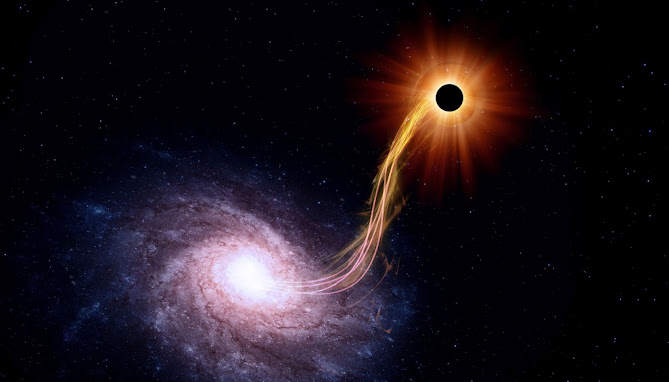THE INVISIBLE MONSTER
A RUNAWAY
BLACK HOLE LEAVES A TRAIL OF STARS
NASA's Hubble Space
Telescope has captured a rare and stunning image of a supermassive black hole
speeding through the universe, leaving behind a never-before-seen trail of
newborn stars. Weighing as much as 20 million Suns, this "invisible
monster" is barreling through intergalactic space at such a high speed
that it could travel from Earth to the moon in just 14 minutes. It has left a
200,000-light-year-long "contrail" of stars, twice the diameter of
our Milky Way galaxy, which scientists believe is the result of a rare and
bizarre game of galactic billiards among three massive black holes.
The black hole, located
at the end of the column of its parent galaxy, has pushed into gas in front of
it to create the new star formation in a narrow corridor rather than consuming
the stars ahead of it. The trail of stars created is almost half as bright as
its host galaxy, making it a remarkable discovery. Scientists are still trying
to understand exactly how the phenomenon works, but they believe that the gas
in front of the black hole gets shocked due to the supersonic, high-velocity
impact of the black hole moving through the gas.
Pieter van Dokkum of
Yale University, who spotted the black hole accidentally while looking for
globular star clusters in a nearby dwarf galaxy, said that the trail of stars
is "quite astonishing, very, very bright and very unusual." He added
that it was "pure serendipity" that they stumbled upon it. In order
to figure out exactly what they were seeing, Mr. Dokkum and his team did a
follow-up spectroscopy with the W. M. Keck Observatories in Hawaii, where they
ultimately concluded that they were seeing the aftermath of a black hole
speeding through the galaxy.
NASA astronomers
believe that the black hole was set free after two galaxies merged about 50
million years ago, bringing together two supermassive black holes at their
centers. Then a third galaxy came with its one supermassive black hole, and the
three combined to form a "chaotic and unstable configuration."
Researchers believe that one of the black holes gained momentum from the other
two and escaped out of its host galaxy, while the other two took off in the
opposite direction.
The discovery of this
runaway black hole and its spectacular trail of stars has left scientists
excited about the possibilities of studying and understanding black holes
better. The next step is to confirm the explanation behind the black hole using
the James Webb Space Telescope and the Chandra X-ray Observatory for follow-up
observations.
Black holes have always
been a mystery to scientists, and discoveries like this one bring us closer to
understanding their nature and behavior. With advanced technology and continued
research, we may someday unlock the secrets of the universe's most enigmatic
entities.


